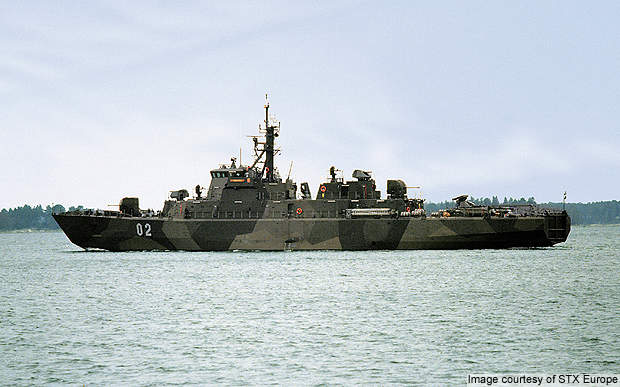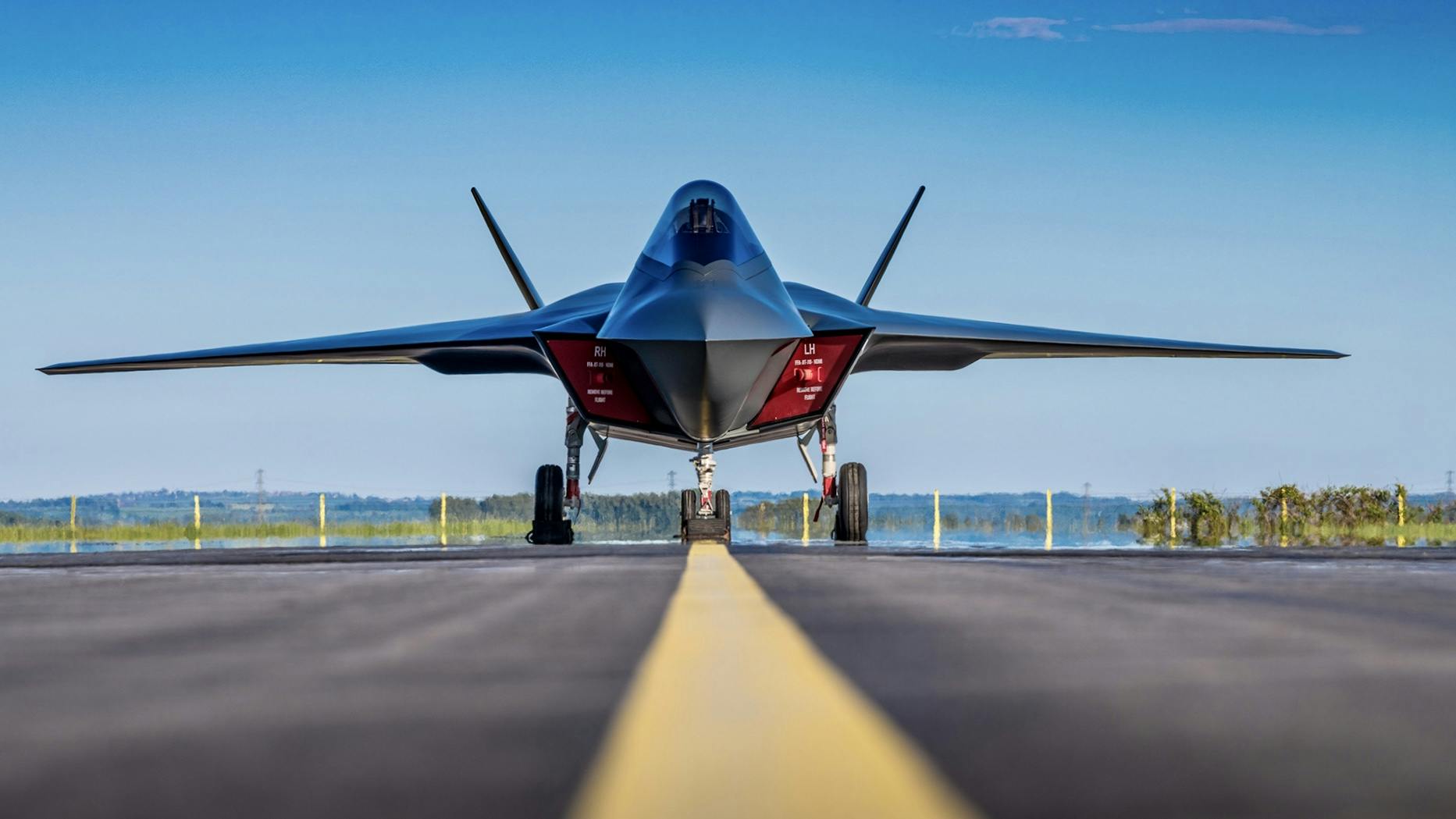L10 Combat Support Ship
The Swedish Armed Forces plan to acquire two L10 combat support ships designed to provide naval vessels with logistic support and transport capacity. The ships will also augment the existing strategic sealift capability. Under the Combat Support Ship (or L10) project, the RSwN is examining options for a Ro-Ro based ship which would provide, in a joint sea base: an assault capacity for amphibious troops; defensive and offensive capability (including self-defence, C4I, aviation - including capacity for a significant helicopter capability - and land attack systems); a logistics (transport, supply - including replenishment at sea - and repair) capability; speed and sustainability in deployment; and the capacity to support humanitarian operations, for example with medical facilities and with the capacity to deploy materials ashore or to support the evacuation of non-combatants.
Other ships of similar type and role might include the Royal Navy's Bay-class Landing Ship Dock (Auxiliary) ship; the German Elbe Type 404 and Berlin Type 702 class replenishment ships; the Rotterdam-class Landing Platform Dock ship; the French Mistral-class Amphibious Assault, Command and Force Projection ship; and the Royal Singaporean Navy's LTS140- class ship.
The Swedish Armed Forces plan to acquire two L10 combat support ships designed to provide naval vessels with logistic support and transport capacity. The ships will also augment the existing strategic sealift capability. The ships will be used for transportation and landing operations as well as to serve as logistics vessels and parent ships to meet a range of afloat replenishment, logistics, sealift and amphibious support missions. It will remedy shortfalls in afloat logistic support, overcome limitations on the deployability of the amphibious battalion, and provide the ability to support helicopter operations in the maritime domain.
The requirement for the new multirole vessel – given the designation L10 – was first identified by the Royal Swedish Navy in late 2005/early 2006 following a capability gap analysis performed by the Naval Staff in the headquarters of the Swedish armed forces. Work to draft an outline staff requirement began in 2007.
Sweden's experience with deploying troops to Chad raised the question of whether the RSwN had a requirement for an upgraded amphibious capability. In 2008 Swedish soldiers were deployed in Chad. The amphibious regiment, Amf 1, was tasked with establishing and training the unit. The majority of the personnel involved were recruited from AM 07, a unit already fully trained and registered. Since spring 2008 a rifle company of 208 men from the Swedish Marines was deployed in Chad, tasked to improve safety for the 400,000 mainly Sudanese refugees, who had entered the country. The troops were originally scheduled for deployment in December 2007, but equipment shortages and increasing violence in Chad resulted in extended delays. As a result, the six month mission was reduced to four months. After accounting for transport time and other preparations, the time that Swedish troops actually spent carrying out their mission was reduced to four to six weeks, to be withdrawn before the onset of the rainy season in June.
The newspapers Svenksa Dagbladet (SvD) and Göteborgs-Posten (GP) both argued that the government should either devote more money to the operation, or simply refrain from sending troops in the first place. GP calls the current circumstances "indefensible" and urges the minister to act quickly or risk having "a glow of shame" be the only lasting impression from Sweden's mission to Chad. The tabloid Aftonbladet did not mince words in its frustration over the situation, calling it "a terrible waste of resources and not morally appropriate" that so much money be devoted to so short a mission. "It sounds rather remarkable that bad weather could force home a Swedish peacekeeping force after just a few weeks. As far as we can tell the refugee camps will still be there—even if it rains."
The new ships would be yet another significant capability leap for the RSwN. Different solutions have been considered. The debate centered on developing a well-armed surface combatant with logistic capabilities, similar to the Danish Absalon-class, or - and perhaps more likely - a lightly armed vessel such as New Zealand's 8,000-ton Canterbury-class Multi-Role Vessel. The key issue is whether the RSwN is seeking a single-, dual- or multi-mission platform. There may, too, be some overlap between the RSwN's surface combatant and amphibious/support platform requirements.
If the ship's main raison d'être was to act as a tender for Sweden's small corvettes and as a vehicle for getting the Amphibs into action overseas, critics think it will be seriously wrong, and won't get the Swedish Navy out of the mess it is in. Such a combat support ship would be configured primarily as a vehicle to make up for the shortcomings of Sweden's current naval forces.
The Visbys and Gotlands have significant capability for providing presence and defensive capability. Sweden's Marines provide some additional bite across the spectrum of operations, and especially at the high end if needed. If Sweden was seeking both to put troops ashore in distant theaters - and especially into non-permissive environments - and to support the Visbys and Gotlands which it wants to keep at sea at greater distances for longer periods, an amphibious and support ship capability would be a significant enabler.
But to be the first step into the future, it must add capabilities. To be really useful, such a ship must be a multi-purpose asset to the entire armed forces, not just the naval forces, for example by being a platform for off-shore support for forces on the ground, such as housing a headquarters or staff, an intelligence unit or a hospital, being a floating base for special forces, providing fire support, etc. Moreover, it must provide useful capabilities which can not readily be leased or borrowed from elsewhere. Transport ships can normally be chartered or leased when needed, bunker support most probably chartered or provided by friendly nations, and if a well-deck for the combat boats on occasion is really needed, there are a number of friendly countries with that capacity.
In 2008 the Swedish Government decided to build two multi-purpose amphibious ships designated as L10. The ships were scheduled for 2014-2015 (though due to economic reasons, only one ship may be commissioned). The project is reportedly being developed by Swedish firm Saltech [but their website makes no mention of this fact].
During 2008 FMV carried out an analysis of the Swedish Armed Forces’ target document and stakeholder requirements and put forward proposals for alternative system design features. The financial assumptions were assessed as permitting the procurement of the ship system and basic combat system. The year-long feasibility study was completed by the FMV in mid-2008, but progress on the project slowed pending the outcome of the government’s Defence Reform process. A tender was initially expected late in 2008 following an anticipated Government decision, the plan was for two ships, due to enter into service 2014 and 2015. Bidding was to be open both to defence and wider commercial contractors (with the latter perhaps providing concepts for a commercial-designed and built Ro-Ro passenger ship). One of the drivers behind opening the bidding to commercial contractors may be to reduce cost.
A series of RoPax concepts were evaluated by FMV in the feasibility phase. The baseline RoPax concept was between 145 meters and 160 meters long, with a displacement of from 12,000-tons to up to 15,000 tonnes at full load. Capacities include a ro-ro deck of approximately 1,250 m2, space for up to 900 m2 cargo on the weather deck, a vehicle deck of 400 linear meters, internal space for 10 Combat Boat 90 craft, and davits port and starboard for two fast supply vessels. Accommodation would be provided for a crew of 55-60, plus an embarked force of around 400 troops at full load.
Another L10 design concept featured a total displacement of 13,430 tons, a cargo deck area will be equal to 2,150 m2, and troops’ capacity of up to 170 people. Its compartment would be able to house two NH90 helicopters. There would be no docking facilities, but the ship would carry twelve Combat Boat 90 (CB 90) assault boats, which can be set afloat by means of a slip or a crane. During 2008, modifications were carried out to adapt 25 Combat Boat 90(CB 90) to enable them to withstand better the tropical conditions likely to be encountered in the course of missions abroad. The boats have been equipped with armor to protect the main armament on the upper deck against small arms fire. The armor is to the same standard as that elsewhere on the boat and it can be replaced if damaged.
By the end of 2009 Sweden’s Defence Materiel Administration (FMV) expected to begin the project definition phase for the purpose-built combat support ship in 2010, intended to enter service in 2015. Following the initial analysis phase, the decision was taken that the requirements were to be stated for a single type of vessel for fleet logistic support and replenishment as well as providing the amphibious lift and sea lift role.
The government’s Defence Reform was passed by parliament in June 2009, endorsing the requirement for the combat support ship to aid elements of the Swedish armed forces engaged on international missions. FMV then contemplated a 15-month project definition phase starting in the second quarter of 2010. On completion FMV planned to issue a request for quotations to industry in mid-2011, with a view to get a contract in the first half of 2012. Acquisition of a modified military off-the-shelf auxiliary oiler replenishment vessel or landing platform dock (LPD)-type ship provided by a naval shipyard is one alternative for the realisation of the combat support ship project.
Janes reports that Commander Kjell-Ove Schramm, L10 requirements officer, speaking at the MAST 2009 conference in Stockholm on 22 October 2009, said that following an initial analysis phase, "the decision was taken that the requirements were to be stated for a single type of vessel for fleet logistic support and replenishment as well as providing the amphibious lift and sea lift role". He added: "The multirole ship solution ... enables us to maximise our sealift capability, which is generally needed for a short duration during the initial phases of an operation, and then shift to the logistic support role, supporting both naval units as well as potentially units ashore if needed."

 euro-sd.com
euro-sd.com




